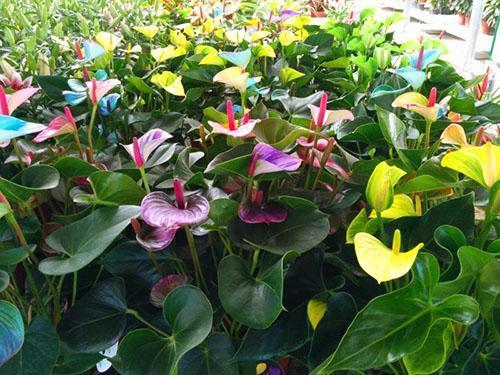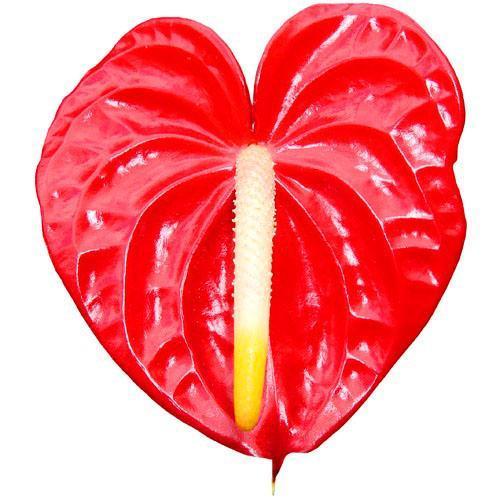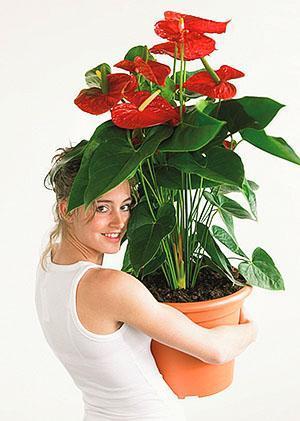Photo and description of popular varieties of anthurium
 Anthurium Andre, the first of the cultivated and described representatives of an extensive species, was brought to Europe in the 70s of the last century. A little later, in 1889, thanks to missionary Samuel Damon, the plants also came to Hawaii. This radically influenced the popularity and distribution of the species, as well as the variety of varieties that growers have today.
Anthurium Andre, the first of the cultivated and described representatives of an extensive species, was brought to Europe in the 70s of the last century. A little later, in 1889, thanks to missionary Samuel Damon, the plants also came to Hawaii. This radically influenced the popularity and distribution of the species, as well as the variety of varieties that growers have today.
Known by many exotic flora lovers as the "heart of Hawaii", anthurium has become a truly local symbol. Plants, whose inflorescences are capable of maintaining decorativeness for 2.5-4 weeks, can be found everywhere here. But anthuriums are not only a decoration for homes and landscapes, but also one of the most important business areas around the world.
More than 12 million plants are grown annually in the Hawaiian Islands alone. An equal number of anthuriums are supplied from other countries and regions. And this is no coincidence. Among tropical flowering species, bright varieties of anthurium, grown as indoor or garden plants for cutting and decorating interiors, occupy a leading position in popularity.
Interest in culture is fueled by the abundance of forms and colors of long-lived inflorescences. Today you can see not only the red anthurium, once found in the jungles of Colombia, but also the two-colored varieties of this plant called Obake, green Midori, white, purple and even brown anthuriums.
Red anthurium - a flower from an old legend

The young beauty sacrificed her own life in the name of love and fidelity. Struck by such selflessness, the gods turned the unfortunate woman into a scarlet flower with a single petal in the shape of a girl's heart.
 Red anthuriums are still considered classics today and are highly valued among flower growers.
Red anthuriums are still considered classics today and are highly valued among flower growers.
Anthurium Dakota can rightfully be called the most famous and widespread variety. At the same time, the plant stands out not only for the rich color of the bedspread, but also for its size from 14 to 23 cm. A large, spectacular plant cannot be overlooked even in a very spacious room.
Anthurium's name comes from Anthos - flower, and Oura - tail. But no less than the tail, the ear is like the long neck of a flamingo. But unlike flamingos, anthurium today can have more than just red or pink colors.
 Anthurium inflorescences of the Minnesota variety stand out from a number of no less spectacular plants with bright scarlet bracts and cobs, which change their white color first to yellow, and then to green.
Anthurium inflorescences of the Minnesota variety stand out from a number of no less spectacular plants with bright scarlet bracts and cobs, which change their white color first to yellow, and then to green.
 The group of Red anthuriums with a prevailing red cover in color is very large and diverse. Anthurium Edison also belongs to it, presented on store shelves not only with plants with red inflorescences, but also varieties blooming in pink tones.
The group of Red anthuriums with a prevailing red cover in color is very large and diverse. Anthurium Edison also belongs to it, presented on store shelves not only with plants with red inflorescences, but also varieties blooming in pink tones.
 In addition to scarlet and classic red varieties, you can also find Dark Red Anthurium. Bracts of such anthuriums, as in the photo, come in all shades from raspberry, wine to burgundy, brown or almost black.
In addition to scarlet and classic red varieties, you can also find Dark Red Anthurium. Bracts of such anthuriums, as in the photo, come in all shades from raspberry, wine to burgundy, brown or almost black.
 An example of brown anthurium is the Otazu Brown variety with a deep burgundy heart-shaped bedspread and a straight light green ear.
An example of brown anthurium is the Otazu Brown variety with a deep burgundy heart-shaped bedspread and a straight light green ear.
 Anthurium varieties Utah willingly form large solemn inflorescences with a glossy textured blanket up to 14 cm in diameter. Anthurium cobs and bracts are purple or deep purple. At the same time, older inflorescences can be easily identified by the green tint at the base of the bedspread.
Anthurium varieties Utah willingly form large solemn inflorescences with a glossy textured blanket up to 14 cm in diameter. Anthurium cobs and bracts are purple or deep purple. At the same time, older inflorescences can be easily identified by the green tint at the base of the bedspread.
 The luxurious black anthurium Black Queen looks even darker thanks to the light coloration of the cob. On the surface of the dense glossy bracts, all the veins stand out in relief, giving the inflorescence a fantastic look.
The luxurious black anthurium Black Queen looks even darker thanks to the light coloration of the cob. On the surface of the dense glossy bracts, all the veins stand out in relief, giving the inflorescence a fantastic look.
Anthuriums in pastel colors
 The rosy, toasty Blush varieties, as well as peach varieties of anthuriums, are extremely highly valued and enjoy the attention of gardeners.
The rosy, toasty Blush varieties, as well as peach varieties of anthuriums, are extremely highly valued and enjoy the attention of gardeners.
The pink Tennessee anthurium has an interesting feature, as it grows up, its covers and cobs change color. If the newly opened bracts are dominated by pure light pink tones, but over time, green shades take their place. The ear of white also turns green.
 Sharing the common varietal name Love anthuriums are a whole family of very attractive indoor plants with large inflorescences and bright glossy foliage. Anthurium variety Lady Love, for example, stands out for its very bright pink bracts, the diameter of which reaches 17 cm.The cobs of the anthurium shown in the photo are even, pointed, of a light yellow shade.
Sharing the common varietal name Love anthuriums are a whole family of very attractive indoor plants with large inflorescences and bright glossy foliage. Anthurium variety Lady Love, for example, stands out for its very bright pink bracts, the diameter of which reaches 17 cm.The cobs of the anthurium shown in the photo are even, pointed, of a light yellow shade.
 But another anthurium of the Fantasy Love variety has a light pink ear, and in the color of the bedspread there are not only pink and green tones, but also white. Darker streaks are clearly visible.
But another anthurium of the Fantasy Love variety has a light pink ear, and in the color of the bedspread there are not only pink and green tones, but also white. Darker streaks are clearly visible.
 The bracts of the Blush anthuriums appear to be browned with a fine pink dusting. The ear in this inflorescence is also white-pink, thinning towards the tip.
The bracts of the Blush anthuriums appear to be browned with a fine pink dusting. The ear in this inflorescence is also white-pink, thinning towards the tip.
Green Anthurium Midori
 All inflorescences of green Midori anthurium have an even green color from the moment the bracts open. Unlike other varieties of anthuriums, this varietal group also has green ears.
All inflorescences of green Midori anthurium have an even green color from the moment the bracts open. Unlike other varieties of anthuriums, this varietal group also has green ears.
 The exception is the Lime Anthurium varieties, which are similar to Midori, but differ in lighter, yellowish bracts and white-yellow cobs.
The exception is the Lime Anthurium varieties, which are similar to Midori, but differ in lighter, yellowish bracts and white-yellow cobs.
White anthuriums
 Anthurium variety White champion forms graceful inflorescences with a fancifully twisted elongated bedspread and a straight, light lemon shade on the cob. As it matures, the ear changes color, becoming green. The bracts also turn green from the base.
Anthurium variety White champion forms graceful inflorescences with a fancifully twisted elongated bedspread and a straight, light lemon shade on the cob. As it matures, the ear changes color, becoming green. The bracts also turn green from the base.
 Spectacular white anthurium White Heart strikes with the purity and freshness of the pointed heart-shaped bedspread and the unusual bright pink color of the cob for this species.
Spectacular white anthurium White Heart strikes with the purity and freshness of the pointed heart-shaped bedspread and the unusual bright pink color of the cob for this species.
Yellow anthuriums and varieties Orange
 The Picasso cultivar group includes Orange Anthuriums like this one shown here, as well as plants with pink, purple, blue and white bracts.
The Picasso cultivar group includes Orange Anthuriums like this one shown here, as well as plants with pink, purple, blue and white bracts.
According to the description, Picasso anthuriums are small plants suitable for indoor cultivation. A special charm to inflorescences is given by the color of the bedspread thickening towards the tip and base, which makes the flower more voluminous and bright.
 The yellow anthurium shown in the photo belongs to the Lemona variety. Such an inflorescence has a large cover of a delicate lemon shade and a white ear with a green tip.
The yellow anthurium shown in the photo belongs to the Lemona variety. Such an inflorescence has a large cover of a delicate lemon shade and a white ear with a green tip.
Anthurium Obake
 Two-color anthurium hybrids under the general name Obake are of Hawaiian origin and amaze the imagination with unusual combinations of shades on large bracts. The name Obake in Japanese means something changeable, unsteady. Ghosts are also called this word.
Two-color anthurium hybrids under the general name Obake are of Hawaiian origin and amaze the imagination with unusual combinations of shades on large bracts. The name Obake in Japanese means something changeable, unsteady. Ghosts are also called this word.
The color of the bracts of the anthurium cultivar Araceae combines bright red and intense green.
 The coloring of Rainbow Obake anthurium is more complex and includes not two shades, but much more. On a white background, dark pink streaks and a more delicate dusting are noticeable. The base of the bracts is colored in a beautiful green tone.
The coloring of Rainbow Obake anthurium is more complex and includes not two shades, but much more. On a white background, dark pink streaks and a more delicate dusting are noticeable. The base of the bracts is colored in a beautiful green tone.
 The spectacular Mauna Loa Obake belongs to the Tropical Ice group. Its characteristic feature is a light, almost white spot in the center of the bedspread and a delicate green environment. The veins are pink and the ear is white and yellow.
The spectacular Mauna Loa Obake belongs to the Tropical Ice group. Its characteristic feature is a light, almost white spot in the center of the bedspread and a delicate green environment. The veins are pink and the ear is white and yellow.
 The name of this anthurium variety Watermelon Obake very accurately describes the appearance of the inflorescence with a juicy pink center and green edges.
The name of this anthurium variety Watermelon Obake very accurately describes the appearance of the inflorescence with a juicy pink center and green edges.
Anthuriums Tulip with tulip bedspread
 Tulip anthuriums are becoming more and more popular due to the unique shape of the bedspread and the shape of the entire inflorescence. Today in culture there are red, pink, white, purple, lilac and blue anthuriums of this type.
Tulip anthuriums are becoming more and more popular due to the unique shape of the bedspread and the shape of the entire inflorescence. Today in culture there are red, pink, white, purple, lilac and blue anthuriums of this type.
Anthurium Fiorino with a tulip-shaped bedspread of a deep pink-purple hue belongs to the group of small anthuriums. The shape of the inflorescences is very laconic, and thanks to it, the plant easily fits into any interior. The colors of the bedspread and the cob of Fiorino anthurium are bright, and flowering lasts about 4 months.
 Blue Anthurium Princess Alexia Blue will not impress with the size of the inflorescence, but it will certainly not leave indifferent fans of unusual colors. Both the ear and the bedspread of this variety are painted in a beautiful ultramarine shade. But as it matures, green strokes appear at the base of the bedspread.
Blue Anthurium Princess Alexia Blue will not impress with the size of the inflorescence, but it will certainly not leave indifferent fans of unusual colors. Both the ear and the bedspread of this variety are painted in a beautiful ultramarine shade. But as it matures, green strokes appear at the base of the bedspread.
 The yellow anthurium of the Princess Alexia variety with a small bracts and a short, straight ear is no less bright. The bright inflorescence is clearly visible against the background of compact dark foliage.
The yellow anthurium of the Princess Alexia variety with a small bracts and a short, straight ear is no less bright. The bright inflorescence is clearly visible against the background of compact dark foliage.
 Joli anthurium is a miniature representative of a large family of indoor plants. The size of the rosette does not exceed 15–18 cm, which makes it possible to find a place for a rather small anthurium with a pink bracts and the same cob on the narrowest windowsill.
Joli anthurium is a miniature representative of a large family of indoor plants. The size of the rosette does not exceed 15–18 cm, which makes it possible to find a place for a rather small anthurium with a pink bracts and the same cob on the narrowest windowsill.
Hello.
Does Princess Alexia Blue exist in nature or are dyes used?
The Dutch company Rijnplant grows blue (Princess Alexia Blue) and bright yellow anthuriums (Princess Alexia Yellow) in its nurseries. Initially, plants of the white-flowered variety Anthurium andreanum Princess Alexia are grown with the introduction of dyes directly into the flower stems. Note the ear of blue anthuriums. It is bluish-greenish, not yellow, as in natural species.
Good day! I bought blue anthurium seeds. But it seems to me that this is a completely different plant, judging by the shoots ((
There is no blue or blue color in the anthurium genes. To obtain a similar color of the cover of the flower, special injections are made into the peduncle. It is difficult to say exactly what kind of plant you have grown. You need to wait for the appearance of 4-6 real leaves. The leaves of your plants are most likely velvety, which is not typical of anthuriums. Definitely - this is not anthurium.
I bought an anthurium. Tell me, is it definitely anthurium and will it bloom someday?
In order for the plant to bloom, follow the recommendations described in the article https://myvilla.decorexpro.com/en/chto-delat-esli-ne-cvetet-komnatnyy-anturium/
Hello, and tell me, please, does the pheoletic anthurium really exist or, like blue, is the shade achieved with the help of injections? Thank.
I saw only red and pink "live". But on the Internet I found this information: there is a small-colored variety of anthurium purple Fiorino and blue Princess Alexia. The unusual purple and blue color was obtained thanks to breeders by introducing piece dyes into the root system of plants.